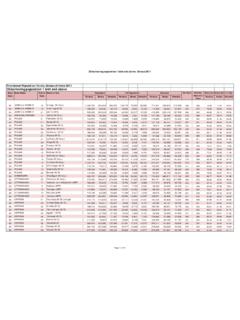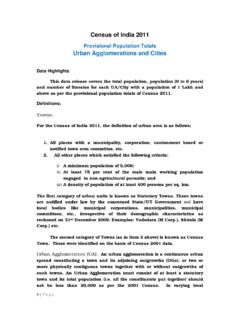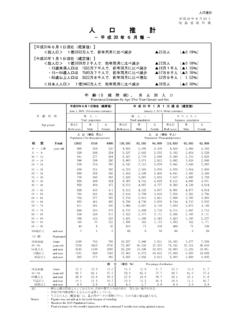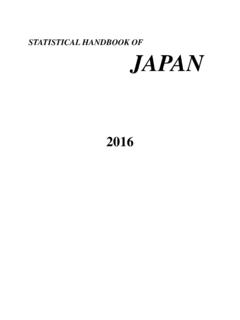Transcription of EHEC outbreak in Germany - World Health …
1 PUBLIC Health REVIEW OF THE. ENTEROHAEMORRHAGIC ESCHERICHIA. COLI outbreak IN Germany . 10 June 2011. World Health Organization 2011. All rights reserved. The Regional Office for Europe of the World Health Organization welcomes requests for permission to reproduce or translate its publications, in part or in full. The designations employed and the presentation of the material in this publication do not imply the expression of any opinion whatsoever on the part of the World Health Organization concerning the legal status of any country, territory, city or area or of its authorities, or concerning the delimitation of its frontiers or boundaries. Dotted lines on maps represent approximate border lines for which there may not yet be full agreement.
2 The mention of specific companies or of certain manufacturers' products does not imply that they are endorsed or recommended by the World Health Organization in preference to others of a similar nature that are not mentioned. Errors and omissions excepted, the names of proprietary products are distinguished by initial capital letters. All reasonable precautions have been taken by the World Health Organization to verify the information contained in this publication. However, the published material is being distributed without warranty of any kind, either express or implied. The responsibility for the interpretation and use of the material lies with the reader. In no event shall the World Health Organization be liable for damages arising from its use.
3 The views expressed by authors, editors, or expert groups do not necessarily represent the decisions or the stated policy of the World Health Organization. 2. INTRODUCTION. Enterohaemorrhagic Escherichia coli ( ehec ) is a human pathogenic E. coli bacterium that is able to cause haemorrhagic colitis (bloody diarrhoea), which sometimes develops into haemolytic uraemic syndrome (HUS). HUS is a life-threatening disease that causes kidney damage and is a severe complication of ehec infection. ehec belongs to the so-called Shigatoxin-producing E. coli (STEC), also known as verocytotoxin-producing E. coli (VTEC). Animals can carry other types of STEC/VTEC in their intestines that are not necessarily pathogenic for humans.
4 Every year there are ehec outbreaks in different parts of the World including Europe, sometimes involving HUS and even deaths, but the number of affected people is normally very much lower than what Germany is now experiencing. In 1996, the World 's biggest recorded outbreak was registered in Japan and included over 8 000 reported cases. ehec outbreak : CURRENT EPIDEMIOLOGICAL SITUATION. Germany informed WHO about an outbreak of ehec infections in Germany through the European Union Early Warning and Response System (EWRS) on 22 May 2011. In accordance with the International Health Regulations, a formal notification from Germany to WHO was received the following day. Epidemiological situation in Germany From 1 May to 9 June 15:00 CET, Germany has reported 759 cases of HUS, including 21 fatal cases.
5 68% of cases are female and 88% adults aged 20 years or older, with the highest attack rates per 100 000 population in the 20 49 age groups. From 1 May to 9 June 15:00 CET, Germany has reported 2229 cases of ehec infections without HUS, 9 of which were fatal; 60% of cases are female and 88% adults aged 20 years or older. Most patients are from northern Germany and the area around Hamburg is especially affected. According to the Robert Koch Institute, as of 9 June the number of notified HUS/ ehec cases reported to it has declined over the past few days. The daily absolute and relative numbers of patients presenting to hospital emergency departments with bloody diarrhoea have also decreased.
6 It is still uncertain whether this decline in outbreak activity is due to changes in consumption of raw vegetables and/or the waning of the source of infection. Epidemiological situation in other countries As of 9 June, 36 HUS (one fatal) and 63 ehec cases (none fatal) had been reported from 13 other European countries. The European Union (EU) countries are reporting their cases using a common EU. case definition, which has been coordinated by the European Centre for Disease Prevention and Control (ECDC). This EU case definition can be found at: In addition, as of 9 June 2011 the Centers for Disease Control and Prevention (CDC) in Atlanta, United States of America, have published information about 3 HUS cases (1 confirmed and 2.)
7 Suspected) and 1 suspected ehec case (without HUS) linked to this outbreak . On 7 June, the Public 3. Health Agency of Canada reported one suspected case of E. coli O104 infection (without HUS), with travel history to Northern Germany and with links to a confirmed case of E. coli O104 infection in Germany . The confirmation of the serotype O104 is still pending as of 10 June. All except two of the above HUS and ehec cases had travelled to or from Germany during the incubation period for infection, typically 3 to 4 days post-exposure (range 2 10 days). The ehec case reported by Norway gave no travel history to Germany , but had a visitor from Hamburg during the incubation period.
8 The visitor is currently hospitalized in Germany with ehec infection. The first fatal HUS case outside Germany was reported by Sweden on 31 May. Another case from Denmark has now known link to Germany . Globally, therefore, 798 cases of HUS (22 fatal) and 2294 cases of ehec without HUS (9 fatal) have been officially reported as of 7 June 2011, making the total number of reported cases 3092, out of which 31 (1%) have been fatal. The table shows totals for all affected countries. HUS ehec Comments Country Cases Deaths Cases Deaths Austria 1 0 3 0. Canada 0 0 1 0. Czech A tourist from the United States who had 0 0 1 0. Republic travelled in Germany Denmark 8 0 12 0. +7 cases of bloody diarrhoea not yet France 0 0 2 0.
9 Confirmed as ehec . Germany 759 21 2229 9. Greece 0 0 1 0 A German tourist Luxembourg 0 0 1 0. Netherlands 4 0 4 0. Norway 0 0 1 0 Contact with a German national in Norway Poland 2 0 0 0. Spain 1 0 1 0. Sweden 17 1 30 0. Switzerland 0 0 5 0. United 3 0 2 0 All 5 cases confirmed Kingdom United States 3 HUS cases (1 confirmed and 2 suspected). 3 0 1 0. of America and 1 suspected ehec case Total 798 22 2294 9. Note As ehec and HUS have exclusive notification categories, the case numbers should not overlap. However, the figures in any rapidly evolving outbreak , however, are provisional and subject to change for a variety of reasons. In providing the above information, WHO wishes to recognize the contribution of its Member States, and technical partners such as the European Commission, the European Centre for Disease Prevention and Control and a number of WHO collaborating centres.
10 4. Groups at highest risk Although in previous ehec outbreaks young children have been identified as the group at highest risk of severe disease, the current outbreak is unusual as it is affecting adults (88% are 20 years or older), mainly women (currently 60% of the ehec cases and 69% of the HUS cases). Cases have also occurred in school-aged children. Causal agent An increasing number of cases are laboratory confirmed as ehec serotype O104:H4. This is a rare serotype that does not seem to have been documented in outbreaks before, although a few sporadic cases with ehec O104:H4 have been reported previously. The outbreak strain is shigatoxin (stx2a)- positive, intimin-negative (eae) and enterohaemolysin (hyl)-negative.













